Слайд 2Victorian Age
Critical Realism and Chartist Literature
The poetry and drama
Critical Realism at the

Turn of Ages
Naturalism
Neoromanticism
Estheticism
Слайд 31. Victorian Age
Victoria became queen of Great Britain in 1837- the longest

reign in English history (until 1901);
Great economic, social, and political changes;
The English Empire covered a fourth of the world’s land;
Industry and trade expanded rapidly;
Railroads and canals crisscrossed the country;
Science and technoloy made great advances;
The middle class grew enormously;
By the 1850s more people were getting an education;
The government introduced democratic reforms (the right to vote);
Слайд 4Victorian Age
Factory and farm workers lived in terrible poverty (England as two

nations – one rich and one poor);
The second half of the 1800s – new scientific theories challenged many religious beliefs – Charles Darwin “The Origin of Species” – traditional values could no longer guide people’s lives;
Writers dealt with the contrast between the prosperity of the middle and upper class and the wretched condition of the poor;
The late 1800s – the analysis of the loss of faith in traditional values.
Слайд 52. Critical Realism and Chartist Literature
The novel – is the leading

form of literature;
The novel is a medium for a communication both intimate and public; a medium of a personal point of view;
New models of interaction between authors and the public – giving public readings, receiving prestigious prizes, giving interviews in the media;
Novelist is a public figure;
Writers are concerned to meet the tastes of a large middle class reading public than to please aristocratic patrons;
Long works with numerous characters; actual events of the day.
Слайд 62.Charles Dickens
Confirmed the trend for serial publication;
His works are accessible to

readers of all classes;
The “Pickwick Papers” – is a masterpiece of comedy;
“David Copperfield” – is judged to be his autobiographical novel;
He gave his public readings in GB and the USA;
The theatre is an escape from the world – “Nickolas
Nickleby”;
The characters are among the most memorable in English literature;
Слайд 72. Style of writing
He used his rich imagination, detailed memories of his

childhood to enliven his fiction;
The technique of writing in monthly /weekly installments – to analyze his relationship with his illustrators;
Exposure to the opinions of his readers – to witness the public reaction and alter the story depending on those public reactions.
Слайд 8Victorian fiction
William Makepeace Thackeray created a masterpiece in “Vanity Fair”;
The Bronte sisters

– Emily, Charlotte, and Anne – created emotionally powerful works (psychologically tormented characters); Emily’s “Wuthering Heights” and Charlotte’s “Jane Eyre” are ranked among the greatest works of the period.
Слайд 9Nonfiction
Writers dealt with the ills of the time;
Thomas Carlyle attacked the

greed and hypocrisy in society – “Sartor Resartus”;
John Stuart Mill discussed the relationship between society and the individual – “On Libertya”
Слайд 10Leading late Victorian novelists
George Eliot’s (Mary Ann Evans) novels are held in

the highest regard for their combination of literary detail with an intellectual breadth; depiction of social and moral problems – “Middlemarch”;
George Meredith’s novels are noted for their sophisticated psychological treatment of characters – “The Ordeal of Richard
Feverel”;
Слайд 11Leading late Victorian novelists
Anthony Trollope’s novels are gentle satires of life in

rural England; they tell of conflicts within the Church – “Barchester Towers”;
Thomas Hardy wrote realistic stories in which the characters are defeated by a hostile fate - “Jude the Obscure”
Слайд 12Chartist Literature
Chartism – is the consequence of the social and historical development

of England and the struggle between upper and middle classes;
It was the early revolutionary and democratic stage of struggle; preparation for a social revolution;
Chartists fought for franchise;
Representatives – Elizabeth Barrett-Browning, Thomas Hood, George Harney,
Ernest Jones
Слайд 133. Poetry
A pessimistic tone- Lord Alfred Tennyson – intellectual and religious
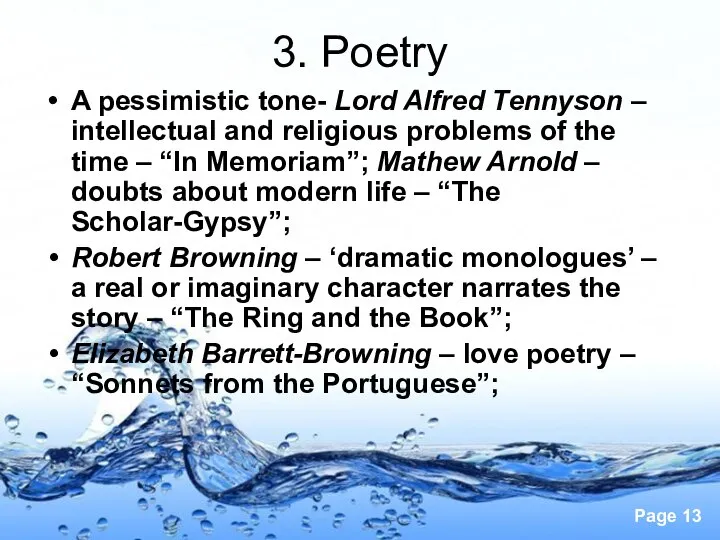
problems of the time – “In Memoriam”; Mathew Arnold – doubts about modern life – “The Scholar-Gypsy”;
Robert Browning – ‘dramatic monologues’ – a real or imaginary character narrates the story – “The Ring and the Book”;
Elizabeth Barrett-Browning – love poetry – “Sonnets from the Portuguese”;
Слайд 14Poetry
John Ruskin, Dante Rossetti – were multi-disciplinary talents;
Edward Lear – was
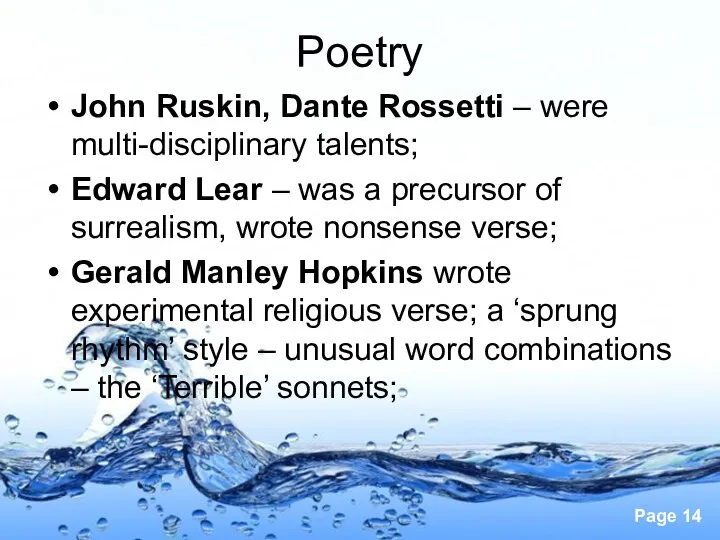
a precursor of surrealism, wrote nonsense verse;
Gerald Manley Hopkins wrote experimental religious verse; a ‘sprung rhythm’ style – unusual word combinations – the ‘Terrible’ sonnets;
Слайд 15Groups of poets
The ‘Yellow Book’ poets – Algernon Charles Swinburne, Oscar Wilde,
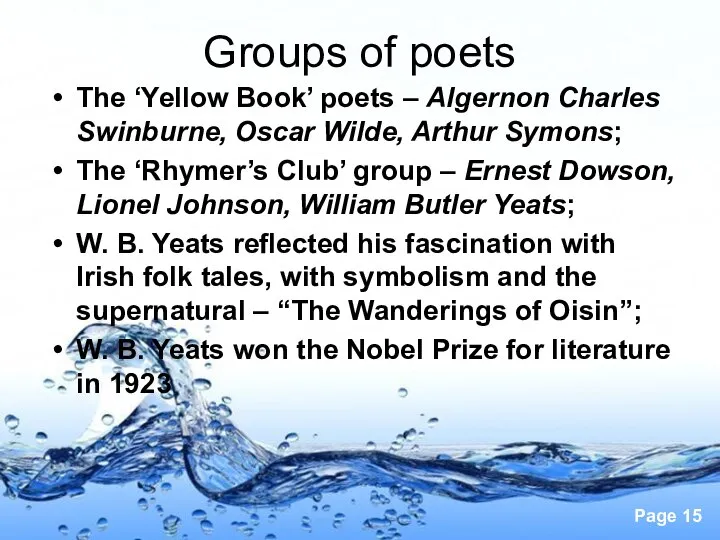
Arthur Symons;
The ‘Rhymer’s Club’ group – Ernest Dowson, Lionel Johnson, William Butler Yeats;
W. B. Yeats reflected his fascination with Irish folk tales, with symbolism and the supernatural – “The Wanderings of Oisin”;
W. B. Yeats won the Nobel Prize for literature in 1923
Слайд 16Drama
By 1900 playwrights revived the English theater – witty comedies and
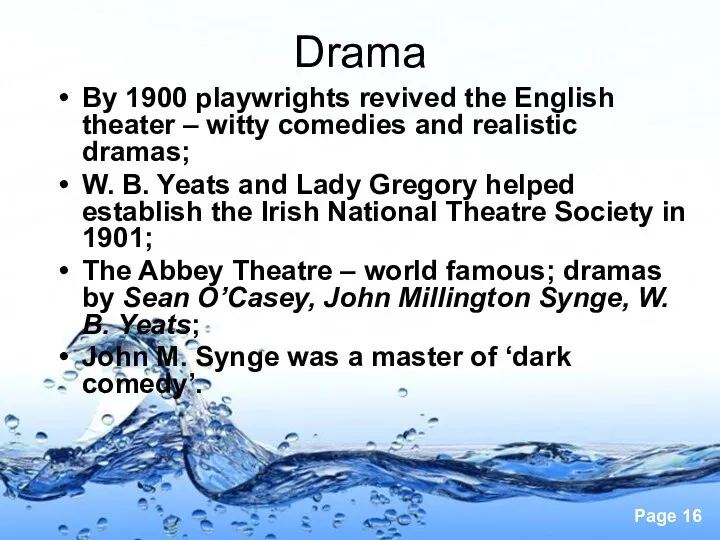
realistic dramas;
W. B. Yeats and Lady Gregory helped establish the Irish National Theatre Society in 1901;
The Abbey Theatre – world famous; dramas by Sean O’Casey, John Millington Synge, W. B. Yeats;
John M. Synge was a master of ‘dark comedy’.
Слайд 174. Critical Realism at the Turn of Ages
1901-1914 – novels and plays
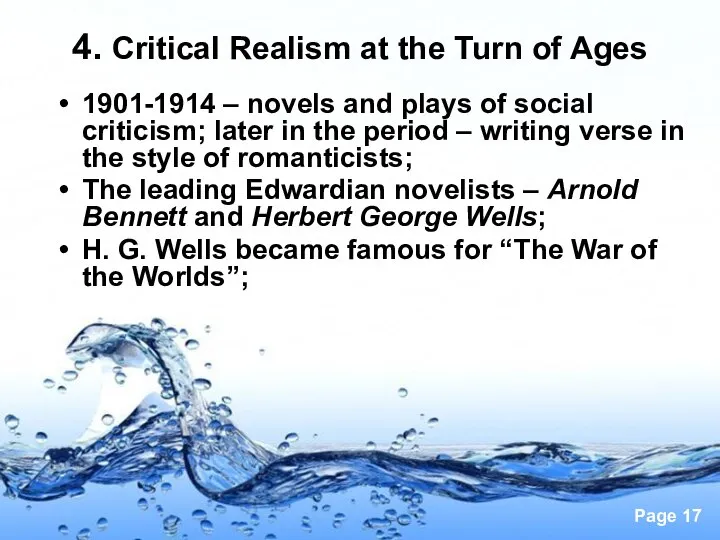
of social criticism; later in the period – writing verse in the style of romanticists;
The leading Edwardian novelists – Arnold Bennett and Herbert George Wells;
H. G. Wells became famous for “The War of the Worlds”;
Слайд 184. Critical Realism at the Turn of Ages
The literature became intellectualized, more
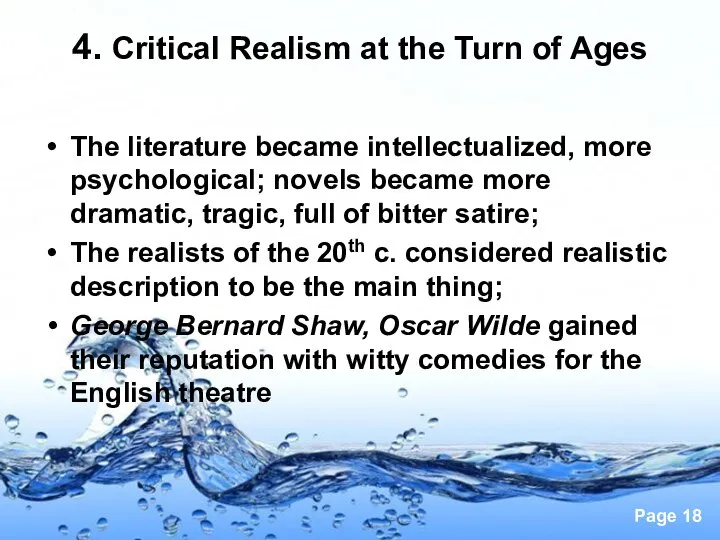
psychological; novels became more dramatic, tragic, full of bitter satire;
The realists of the 20th c. considered realistic description to be the main thing;
George Bernard Shaw, Oscar Wilde gained their reputation with witty comedies for the English theatre
Слайд 19The Modernist Movement
20th c. writers felt alienated from mainstream, responded by
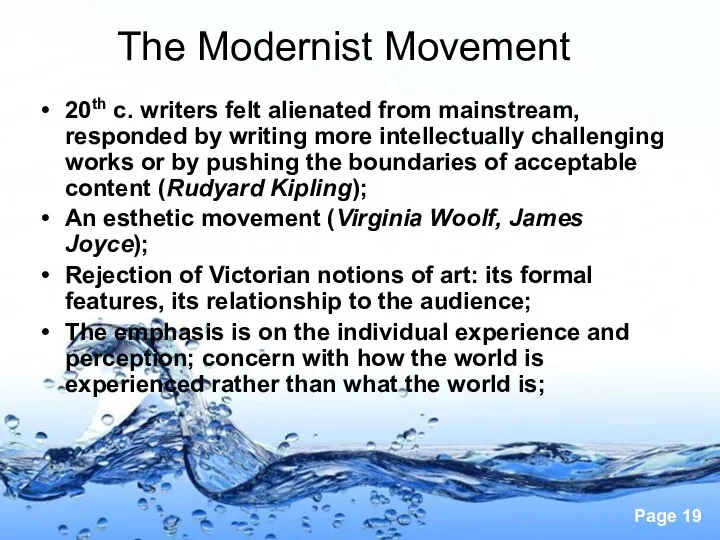
writing more intellectually challenging works or by pushing the boundaries of acceptable content (Rudyard Kipling);
An esthetic movement (Virginia Woolf, James Joyce);
Rejection of Victorian notions of art: its formal features, its relationship to the audience;
The emphasis is on the individual experience and perception; concern with how the world is experienced rather than what the world is;
Слайд 20Modernist movement
Stream-of-consciousness writing;
Movement away from fixed narrative point of view – an
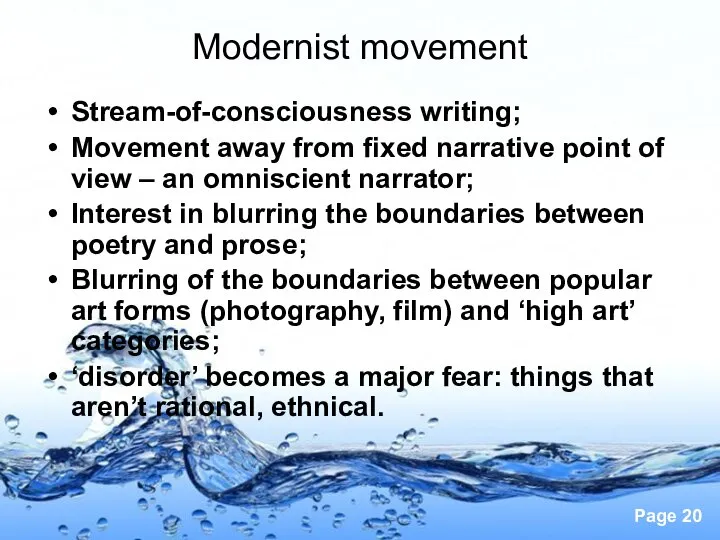
omniscient narrator;
Interest in blurring the boundaries between poetry and prose;
Blurring of the boundaries between popular art forms (photography, film) and ‘high art’ categories;
‘disorder’ becomes a major fear: things that aren’t rational, ethnical.
Слайд 215. Naturalism
The trend developed on the basis of democratic ideas;
Writers depicted
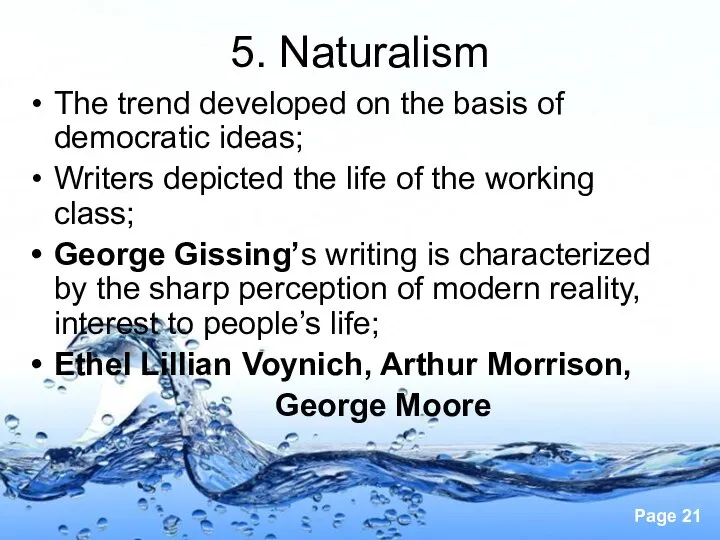
the life of the working class;
George Gissing’s writing is characterized by the sharp perception of modern reality, interest to people’s life;
Ethel Lillian Voynich, Arthur Morrison,
George Moore
Слайд 226. Neoromanticism
Writers contradicted a strong and bright personality to the evils
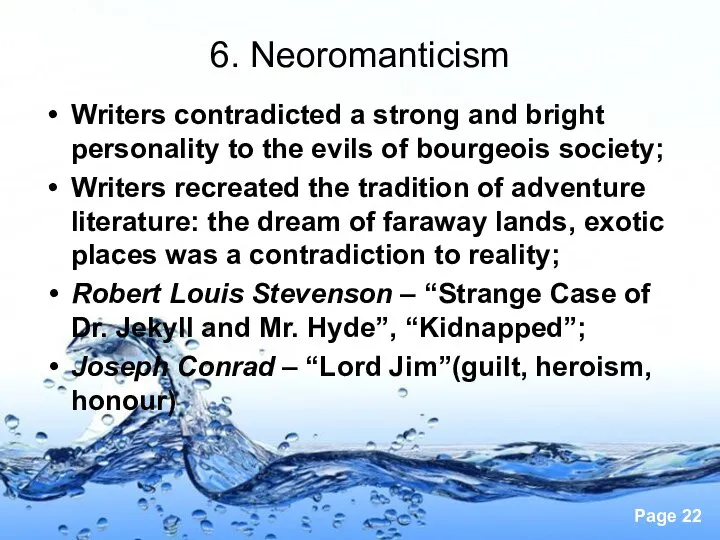
of bourgeois society;
Writers recreated the tradition of adventure literature: the dream of faraway lands, exotic places was a contradiction to reality;
Robert Louis Stevenson – “Strange Case of Dr. Jekyll and Mr. Hyde”, “Kidnapped”;
Joseph Conrad – “Lord Jim”(guilt, heroism, honour)
Слайд 23Trends
‘Bloombury Group’ – a group of writers and artists discussed intellectual
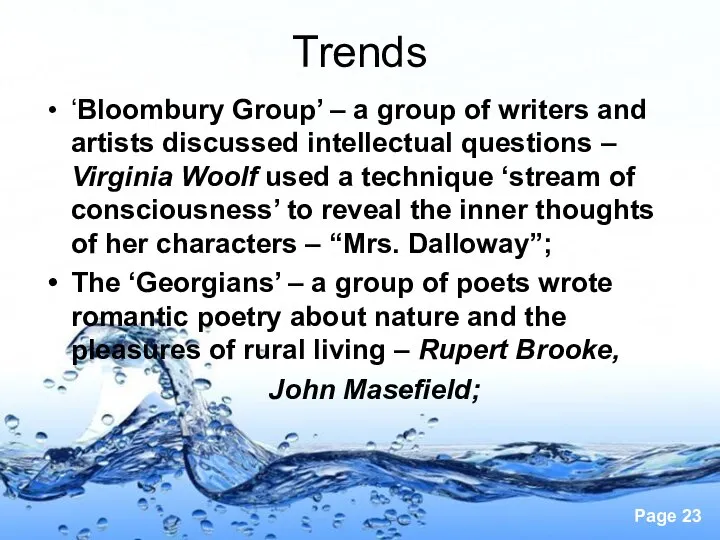
questions – Virginia Woolf used a technique ‘stream of consciousness’ to reveal the inner thoughts of her characters – “Mrs. Dalloway”;
The ‘Georgians’ – a group of poets wrote romantic poetry about nature and the pleasures of rural living – Rupert Brooke,
John Masefield;
Слайд 24Scottish literature
The ‘Kailyard tradition’ – elements of fantasy and folklore – James
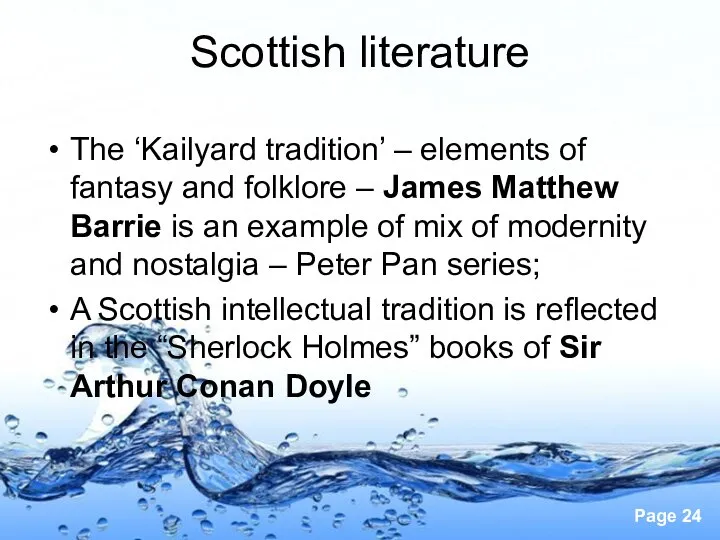
Matthew Barrie is an example of mix of modernity and nostalgia – Peter Pan series;
A Scottish intellectual tradition is reflected in the “Sherlock Holmes” books of Sir Arthur Conan Doyle























 СРАВНИТЕЛЬНЫЙ АНАЛИЗ САЛОННЫХ ФИЛЬТРОВ
СРАВНИТЕЛЬНЫЙ АНАЛИЗ САЛОННЫХ ФИЛЬТРОВ Speaking about famous people
Speaking about famous people Презентация на тему Политическая система и политический режим
Презентация на тему Политическая система и политический режим  Формы размножения организмов. Жизненный цикл организмов и характер смены поколений
Формы размножения организмов. Жизненный цикл организмов и характер смены поколений EXCITABLE TISSUES
EXCITABLE TISSUES Теоретические основы электротехники. Переходные процессы в неразветвленных линейных электрических цепях. (Часть 1)
Теоретические основы электротехники. Переходные процессы в неразветвленных линейных электрических цепях. (Часть 1) Правильный многоугольник
Правильный многоугольник Тема урока:«Начальные геометрические сведения. Параллельные прямые»
Тема урока:«Начальные геометрические сведения. Параллельные прямые» Презентация на тему Розы из кленовых листьев
Презентация на тему Розы из кленовых листьев  Юридическая ответственность (10 класс)
Юридическая ответственность (10 класс) Бисер, вышивка бисером
Бисер, вышивка бисером Из чего что сделано Окружающий мир 2 класс
Из чего что сделано Окружающий мир 2 класс Даму Регионы. Программа финансирования
Даму Регионы. Программа финансирования Раздел #. Дизайн интерьера. Заркуа Тамара Лазаревна
Раздел #. Дизайн интерьера. Заркуа Тамара Лазаревна Заседание педагогического совета МВ(С)ОУ ОСОШ
Заседание педагогического совета МВ(С)ОУ ОСОШ Интенсивный курс повышения квалификации специалистов и руководителей для проверки знаний по охране труда ЗАКОНОДАТЕЛЬСТВО ОБ
Интенсивный курс повышения квалификации специалистов и руководителей для проверки знаний по охране труда ЗАКОНОДАТЕЛЬСТВО ОБ Зайцы из носков 2
Зайцы из носков 2 Использование умножения одночлена и многочлена при преобразовании алгебраических выражений и решении уравнений
Использование умножения одночлена и многочлена при преобразовании алгебраических выражений и решении уравнений Презентация на тему График квадратичной функции. Неравенства с одной переменной
Презентация на тему График квадратичной функции. Неравенства с одной переменной Go. Eat. Jump
Go. Eat. Jump Рыбные блюда
Рыбные блюда Портреты писателей с животными
Портреты писателей с животными Тепловая обработка овощей
Тепловая обработка овощей Презентация к открытому уроку :Повторение и обобщение по теме «Имя существительное»
Презентация к открытому уроку :Повторение и обобщение по теме «Имя существительное» Проект Атомный диктант
Проект Атомный диктант Распределение и учет общепроизводственных и общехозяйственных расходов
Распределение и учет общепроизводственных и общехозяйственных расходов Презентация на тему Природные богатства и труд людей основа экономики (3 класс)
Презентация на тему Природные богатства и труд людей основа экономики (3 класс) Кто и когда изобрел бумагу?
Кто и когда изобрел бумагу?